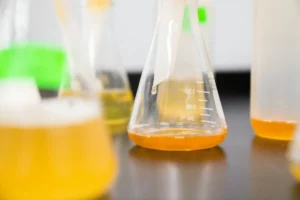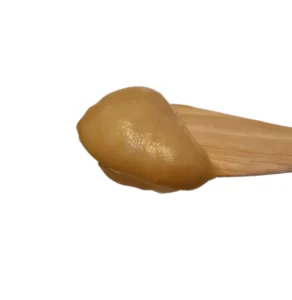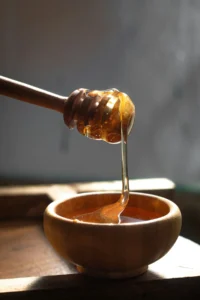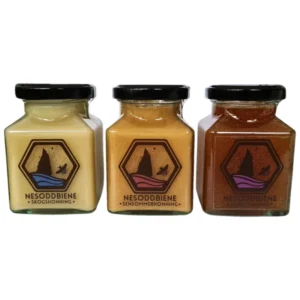Imagine finding a jar of honey in your pantry that’s been there for years. It’s crystallized, maybe a bit thick, but does that mean it has gone bad? Not at all! Honey is one of the few natural foods that never spoils—a fact backed by history and science. But why? And are there any exceptions? Let’s explore the fascinating reasons behind honey’s eternal shelf life and what to do if your honey changes over time.
Why Doesn’t Honey Go Bad?
Honey has been found in ancient Egyptian tombs, still perfectly edible after thousands of years! This natural longevity is due to several key factors:
1. Low Moisture Content – Carefully Monitored by Bees and Beekeepers
Bacteria and mold need water to grow, but honey is incredibly low in moisture. Bees instinctively dehydrate the honey by fanning their wings to reduce moisture levels before sealing it in the honeycomb with wax.
Beekeepers always check the moisture content before harvesting to ensure the honey is properly ripened. In Norway, the Honey Regulations (Forskrift om honning) state that honey must have a moisture content below 20% to be sold as honey. However, we always aim for an even lower moisture content to ensure quality and prevent fermentation.
2. High Sugar Concentration
Honey is about 80% sugar, making it a natural preservative. High sugar content draws moisture away from bacteria, effectively dehydrating and killing them before they can multiply.
3. Natural Acidity (Low pH)
With a pH between 3.2 and 4.5, honey is naturally acidic. This acidity prevents bacterial growth, making it inhospitable for most microorganisms.
4. Hydrogen Peroxide Production
Honey contains glucose oxidase, an enzyme that produces hydrogen peroxide when honey is exposed to moisture. This gives honey additional antimicrobial properties, further preventing spoilage (read more about honey’s antibacterial power here).
Does Honey Ever Go Bad? The Exceptions
While pure, raw honey doesn’t expire, there are a few scenarios where honey can go bad or degrade in quality:
1. Moisture Contamination & Fermentation
If honey is stored improperly and absorbs too much moisture, fermentation can occur. This is one of the biggest risks in honey storage, as excess moisture can activate the natural yeasts present in honey.
A sign of fermentation can be new bubbles forming in the honey, but note that air bubbles may also appear naturally from the jarring process. The best way to check for fermentation is:
✅ Open the jar and wait five seconds
✅ Smell the honey – If it has a strong yeasty or alcohol-like scent instead of its usual sweet aroma, it may have started fermenting.
💡 Did you know? Some people actually enjoy fermented honey (also known as mead honey), but for beekeepers, fermentation is something to avoid!
2. Adulterated or Low-Quality Honey
Commercially processed honey is sometimes diluted with syrups or additives, which can reduce its longevity. Pure, raw honey (like our Norwegian Heather Honey) maintains its natural preservation properties.
💡 How to avoid it? Buy raw, unfiltered honey from a trusted source.
3. Extreme Temperature Changes
While honey is highly stable, extreme heat or direct sunlight can cause it to degrade over time. This can affect its flavor and nutrient content.
💡 How to store it? Keep your honey in a cool, dry place—no need to refrigerate!
What About Crystallized Honey?
If your honey has turned thick or grainy, don’t worry! Crystallization is a natural process, and it actually indicates that your honey is raw and unprocessed (which is a good thing!). Different honeys crystallize at different rates, depending on sugar composition and storage temperature.
💡 How to fix crystallized honey? Simply place the jar in warm water (not boiling) and stir gently until it returns to its liquid state.
📖 Read more about why honey crystallizes and how to restore it here.
How to Store Honey Properly
To keep your honey in perfect condition for years (or even decades), follow these simple storage tips:
✅ Use an airtight container – Glass jars are best.
✅ Store at room temperature – Around 10-20°C (50-68°F) is ideal.
✅ Keep it dry – Avoid exposure to moisture to prevent fermentation.
✅ Avoid direct sunlight – Store in a cupboard, away from heat sources.
Final Verdict: Honey Never Spoils (If Stored Properly!)
Honey’s natural preservative powers make it one of the longest-lasting foods on Earth. Whether it’s been in your pantry for a year or a decade, if stored correctly, it’s still good to eat. The next time you see honey that’s darkened or crystallized, don’t toss it—just warm it up and enjoy!
If you’re looking for pure, raw honey, check out our collection of Norwegian honeys. 🍯🐝






